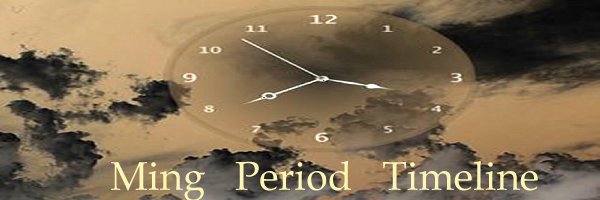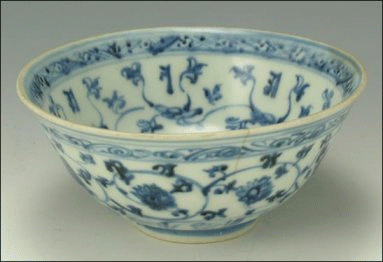
.


Early Ming
|
The Ming Period Timeline is defined in history books as a 276 year span with the figures below being provided. They show the first 56 years of the dynasty assigned as Early Ming, the next 165 years of the dynasty assigned as Middle Ming which is further broken down into early Middle, and later Middle, and the last 55 years of the dynasty are seen as Late Ming. Here is the breakdown:
I've not been able to figure out exactly how the above timelines were determined, nor have I been able to figure out the reasoning. I'm sure the scholars had their reasons. Perhaps they chose the timeline to be similar in perspective and proportion (percentage-wise) to that of the cycle of a living person, whereas childhood is about a 15 year span, adulthood about 45 years, and old age another 15+ or so years. This places the percentages in balance with the figures shown above. Early - 20%, middle - 60%, and late - 20%. This identifies the standard (accepted) dates for Early, Early Middle, Later Middle, and Late Ming dynasty. If you're interested in my own method of identification along with some further notes, read on....... ~~~~~~ Please also note that I follow my own guidelines in my collection when it comes to dating any specific piece. I do not conform to the standard which I believe is misleading and out of balance. I instead use only the terms early, middle, and late when referring to the 276 year span of the Ming dynasty. This makes it quite simple. Divide 276 by 3 for an even 92 years each. This gives us the following:
. I could understand wavering just a few years so to coincide with the end/start of a particular reign. For example, the early Ming span could be lengthened just 4 years to end in 1464 since the reign of Chenghua began in 1465. And likewise, middle Ming could be lengthened just 14 years to end in 1566 when the Jiajing reign ended. This would bring the terms early, middle, and late slightly out of alignment but allow them to coincide with either the end or start of a reign and still fall within a reasonable average. Also, in using this timeline, the important maritime expeditions of Zheng He (Cheng Ho) plus the span of the Interregnum Period would now both fall within the early Ming category instead of overlapping both early and early middle timeframes. Using my method and the slight adjustment suggested, the term Early Ming would span the beginning of the Ming dynasty in the year 1368 through the year 1464 when the reign of emperor Tianshun and the Interregnum Period both came to a close. A total of 96 years. Doing the math is a simple task. Assigning any unmarked piece to different periods within the Ming dynasty however, is a not a simple task. This also applies to certain marked pieces as well since many were produced later in honor of an earlier reign. All we have to go on are the records kept from excavations of strata known to be from a certain period. This also includes that of shipwreck excavation with positive dating. We also have the study of applicable pieces that are accompanied with unquestionable provenance. The latter being documented collections such as the Ardebil Shrine and the Topkapi Surrey Museum which have been studied extensively over the years. Working with this, we can now determine the type and quality of the material used for potting, glaze, and decoration. We can also get a good feel for the style of the period. Now we can make a reasonable assumption to just when within the Ming period the piece in question was made. Many experts use (need) a guideline, feeling more comfortable in saying "It can't be 14th century ...... the base is glazed!" This gives the impression that the 'expert' knows, for if they didn't then they would not appear to be an 'expert'. The truth is that no one knows for sure. We are relying on those best educated in the field to guide us. In other words, an educated guess. Hopefully education provides the best guessers. If you think of this, it's almost an oxymoron. Too many people put emphasis on the word educated, overlooking the importance of the word guess. It is true that most 14th century pieces from the reign of Hongwu have unglazed bases, but there are some with either a rough glaze or even a smooth glaze. Shards excavated from the Hongwu stratum confirm this. This is why I don't use the rule of thumb. Of the scholars I've talked with, and books that I've read, I find there is no clear distinguishing between the early, and middle Ming timeline. Some do describe a criteria to differentiate between the two, and there seems to be no leeway, no exceptions. And then some offer way to much leeway. I suppose having both of these offer safe roads to take, and it certainly makes it easier for the major auction houses to make their declarations which are usually unchallengeable. There were thousands of kilns producing porcelain during the 276 year span of the dynasty. The varying degree of quality produced from these kilns is what has created the difficulty in identifying any unmarked piece to the period in which it belongs. The Chinese took great pride in their work and many private kilns did indeed turn out some fine specimens, not just rough provincial ware. If they were able to do so with good quality materials, an unmarked piece would be quite difficult to identify to it's true period. One of the best aids in identifying early Ming is of course the presence of the imported cobalt known as Mohammedan blue. You can read at length information on this subject from the link I offer on my main page. Rather than go into too much detail, I encourage the reader to just study closely the properties of all pieces in my collection listed as early Ming. They provide very good examples of the period. Keep in mind, going by the pre-established (accepted) timelines, they would probably be classified as either early middle, or later middle Ming. I have never collected in terms of monetary value, I collect for beauty. I find such beauty in a simple piece with hopefully one or more cracks that reveal it's true age. Some would consider this as a flaw in my thinking, and indeed this philosophy removes me from the circle of investors that flock to the major auction houses with their check books in hand. I instead sit back and enjoy what I know to be authentic. I feel lucky to have in my possession something so old and, though tangible, something so alive with such beauty and character. . JP |